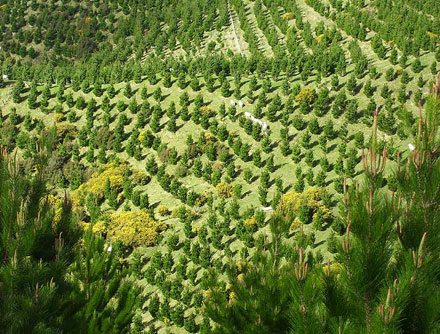
Large areas of forestry have been converted to dairy on the Central Plateau in New Zealand but forestry would stack up better against dairying in the central North Island if environmental factors were taken into account, argues Scion chief executive Dr Warren Parker. Source: Stuff NZ
Dr Parker, who heads the forestry crown research institute, said forests on the Central Plateau were cut down from 2004 to 2015 to increase capital gain without regard for the best land use.
“If you removed the trees and changed to dairy the value of the land went from NZ$8000 a hectare to NZ$40,000. It cost you NZ$15,000/ha to put in the infrastructure but then you walked away with substantial tax-free capital gains,” Dr Parker said.
Dr Parker said that, given the correct market signals, forestry would hold its own against other land uses.
He said as well as creating a price bubble, the distortion of land value without taking into account the externalities meant land was used for the wrong purposes.
Earlier this year Landcorp announced it would stop converting forestry to dairy on Wairakei Estate near Taupo, which comprises 13 dairy farms with 17,000 cows over 6400 hectares. It had originally been planned to run 43,000 cows on 39 farms by 2021.
In a recent co-authored paper, Dr Parker said the economic contribution of dairying to the New Zealand economy was “overstated”.
Over the 10-year period from 2005 to 2015, dairy prices were so volatile that there was a 13% probability of losses, whereas although forestry returns were lower, there were no losses over the same period of time. But farmers are not being penalised for nitrogen and methane pollution, and forestry is not being incentivised with a higher carbon price.
Dairying had made large productivity gains since 1990 through increased stocking rates and increased use of inputs such as water, fertiliser and supplementary feed. But these had brought about a reduction in water quality; higher methane gas emissions; higher demands for surface and groundwater for irrigation – costs which have not been factored into prices charged for dairy products.
If carbon and nitrogen payments were introduced, forestry resulted in a net present value of NZ$16,785/ha, coupled with less volatility, compared with de-intensified dairy (NZ$15,216/ha). At nitrogen prices below NZ$200/kg, dairy is the best alternative use, but once it goes above, forestry is a better bet.
“At currently assumed nitrogen (NZ$400/kg) and carbon (NZ$6.8 a New Zealand unit) prices, forestry is the best alternative,” Dr Parker said. Typically an average dairy farm leaches 56 kilograms of nitrogen per ha, whereas an undisturbed forest leaches only 3kg/ha a year, rising to 28 kg/ha at harvest time on volcanic soils.
Dr Parker said that a price cap on nitrogen, similar to what has been introduced for Lake Taupo and Rotorua, should be set. There, councils have set a price of between $400-650/kg/ha.
“In Taupo there was a cap put on and we removed the nitrogen from the lake so we do know we can create caps and also create the concept of natural capital – that you have to maintain the quality of the environment by paying for carbon and nitrogen,” Dr Parker said.
Regulation was a blunt instrument so it was better to use a market -based incentive. Parker said it was inevitable that farming would soon come within an emissions trading scheme.
“I think farmers are better to be seen inside and contributing to the solution and have an appropriate adjustment period. You don’t go bang and suddenly be exposed to the full impact.”
He said the point of the paper was to show that forestry and dairying were complementary land uses.
“When you look at the sectors we need to look at how they fit in together so forestry and dairy are complementary – one emits emissions and one stores carbon, one leaches nitrogen, one doesn’t. How do the sectors integrate?”
Dr Parker said it might go against the grain of traditional farming boundaries, but a group of farmers might get together to buy or use a block of land that offset their leaching.







